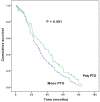Outcomes and Risk Factors for Polymicrobial Posttraumatic Osteomyelitis
- PMID: 29545992
- PMCID: PMC5852844
- DOI: 10.7150/jbji.22566
Outcomes and Risk Factors for Polymicrobial Posttraumatic Osteomyelitis
Abstract
Background: We hypothesized that polymicrobial posttraumatic osteomyelitis (PTO) may be associated with worse outcomes when compared to monomicrobial PTO. We therefore attempted to show the outcomes and predisposing factors associated with polymicrobial PTO. Methods: A single-center case-control study was carried out from 2007 to 2012. The outcome variables analyzed were: the need for additional surgical and antibiotic treatments, rates of amputation, and mortality associated with the infection. Univariate and multivariable analyses using multiple logistic regression were performed to identify risk factors associated with polymicrobial PTO, and p < 0.05 was considered significant. Results: Among the 193 patients identified, polymicrobial PTO was diagnosed in 37.8%, and was significantly associated with supplementary surgical debridement (56.1% vs. 31%; p < 0.01), a higher consumption of antibiotics, and more amputations (6.5% vs 1.3%; p < 0.01). Factors associated with polymicrobial PTO in the multivariable analysis were older age (odds ratio [OR] = 1.02, 95% confidence interval [CI] = 1.01 to 1.03, p = 0.04), working in agriculture (OR = 2.86, 95% CI = 1.05 to 7.79, p = 0.04), open fracture Gustilo type III (OR = 2.38, 95% CI = 1.02 to 5.56, p = 0.04), need for blood transfusion (OR = 2.15, 95% CI = 1.07 to 4.32, p = 0.03), and need for supplementary debridement (OR = 2.58, 95% CI = 1.29 to 5.16, p = 0.01). Conclusions: PTO is polymicrobial in more than one-third of patients, associated with extra surgical and clinical treatment, and worse outcomes including higher rates of amputation.
Keywords: Chronic osteomyelitis; Staphylococcus aureus; monomicrobial infection; polymicrobial infection; posttraumatic osteomyelitis; risk factors.
Conflict of interest statement
Competing interests: The authors declare that they have no competing interests. There is no funding source.
Figures


References
LinkOut - more resources
Full Text Sources
Other Literature Sources

